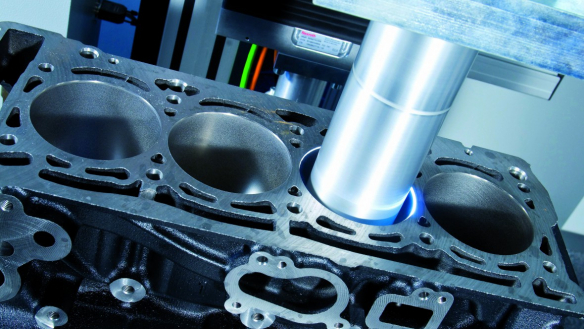Internal friction
Combustion engines are subject to friction losses, in which a portion of the power disappears in the mechanical interaction of the engine components. The greatest losses occur in the crankshaft – at the pistons with their sealing rings, at the connecting rod bearings and at the main bearings of the crankshaft.
In recent years, Audi has devoted a great deal of attention to achieving lower internal friction levels in its engines. In the Production department at the Györ plant, sophisticated methods are being applied to a number of powerplants. The company produces nearly all its engines at its Hungary location.
One of these high-tech methods is plate-honing, in which a plate is bolted onto the crankcase prior to the mechanical honing of the cylinder barrels. This simulates the tension that the cylinder head will later exert and which results in deviations from perfect roundness on the scale of just thousandths of a millimeter. This effect is then accounted for during honing, which is why Audi can fit the pistons with rings with less pretension that slide easily in the barrels. Tangential forces are thus reduced by around 35 percent.
A similar effect is achieved with a technique that involves exposing the cylinder barrels to a laser. Here a pulsed beam of light is used to melt the uppermost layer of metal (high-strength vermicular graphite cast iron) very slightly. The molten material solidifies almost instantly, after which its hardness is almost double the previous value. The countless tiny furrows formed by this process fill up with engine oil during operation, providing optimum lubrication for the pistons. When designing the piston rings, there is essentially no need to take subsequent wear into account, and the ring tension decreases.
Another interesting new solution is DLC-coating of piston pins, which Audi uses on its 1.6-liter TDI. Developed in motorsport, diamond-like carbon (DLC) technology entails the use of a fine diamond-like carbon coating that provides extreme hardness, wear-resistance and minimal friction. In theory, the extremely thin DLC coating is also a candidate for use on gear wheels and a number of components in the cylinder head.
Depending on the engine, Audi uses two further methods for reducing friction. These target the main bearings for the crankshaft and their sealing rings, the valve gear and valve springs, and the drive for the camshafts and ancillary equipment. The new 3.0 TDI, for example, needs only two chains here, whereas the previous engine still used four chains and a toothed belt.
Audi’s philosophy of downsizing also means a reduction in internal friction: with less displacement, the pistons, bearings and ancillary equipment become significantly smaller.
Status: 2011
